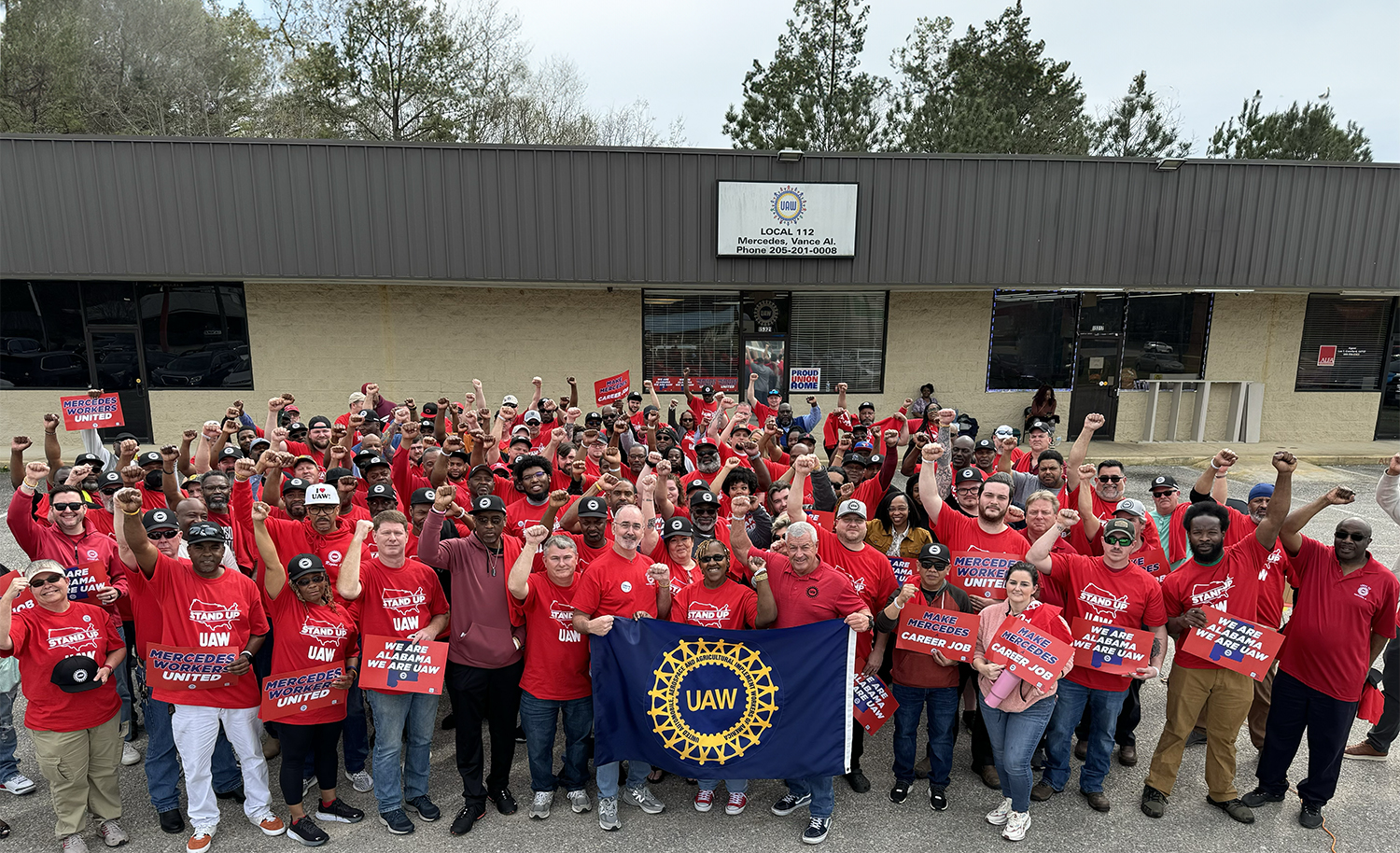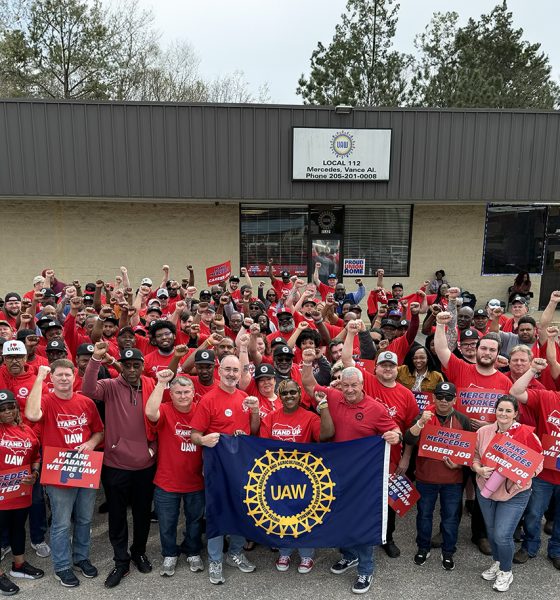Dodge, Chrysler, and Jeep’s multinational parent company Stellantis has filed several lawsuits against the United Automotive Workers (UAW) union, after the organization has been threatening to strike against the automaker over claims that contract promises have not been upheld.
Stellantis filed an initial lawsuit against the UAW and Local 230 on Thursday in the U.S. District Court for the Central District of California, claiming that a strike would be illegal and would violate the parties’ contract. Then, on Friday, Stellantis filed eight additional lawsuits against the union and local chapters over recent strike threats, along with claiming that it rejected requests over the weekend to re-boot a defunct jobs’ bank program for employees affected by the closing of a Belvidere, Illinois factory.
The automaker filed the suits against the UAW and 23 separate local chapters, including one against seven local chapters filed in the U.S. District Court for the Eastern District of Michigan—though the UAW has denied attempting to re-boot the jobs bank program.
“The company rejected the UAW’s latest proposal because it would revert to prebankruptcy terms and conditions that would jeopardize the company’s future,” Stellantis said in a statement on Monday (via Automotive News). “The company understands that this situation is extremely unsettling for its Belvidere employees, which is why it agreed during 2023 negotiations to place these employees on temporary layoffs, which provide 74 percent of pay and full healthcare benefits.”
The jobs bank benefits were adopted by the “Big Three” automakers in the 1980s, effectively allowing workers to remain on active payroll despite not being allowed to work. According to Stellantis, over 2,000 employees in the jobs bank remained at a “staggering cost.”
The suits come after the UAW has been threatening to strike against Stellantis for the last few weeks, and after it filed a federal charge of unfair labor practices against the automaker last month.
The union has been threatening strikes Stellantis over claims that it has failed to uphold an agreement from last year’s contract to re-open the Belvidere Assembly Plant after it was closed indefinitely in February 2023. Following the closure, around 1,300 employees were left without work.
RELATED: Stellantis starts search for CEO successor amidst inventory woes
UAW Stellantis Director Kevin Gotinsky denied claims that the union was re-booting the job bank program in a follow-up statement on Monday, instead pointing to the company’s need to keep to promises to re-open the retired Illinois plant to avoid the strikes.
“If Stellantis lives up to its commitments and reopens Belvidere Assembly and builds the Belvidere parts Megahub, our members will be back to work soon and the cost to the company will be minimal,” Gotinsky said. “These employees can and are willing to perform work today. That is all they want, to have a future and be able to provide for their families as agreed to in our contract.”
UAW President Shawn Fain also issued a statement in response to the news:
Stellantis, formerly FCA, formerly Cerberus, formerly Daimler, formerly Chrysler, is following in a long line of failing corporate executives blaming autoworkers for their own mismanagement.
It is gross mismanagement by top executives that is killing this company. It is laughable that Stellantis claims our proposal to reopen Belvidere is ‘outrageous.’ In just the last 9 weeks, Stellantis has pissed away $1 billion in stock buybacks for a total of $3 billion in stock buybacks this year. Our proposal would cost a fraction of that and would go directly to the autoworkers who have built this company.
Everyone knows the so-called ‘jobs bank’ didn’t cause the 2008 bankruptcies, and autoworkers aren’t responsible for CEO Carlos Tavares’ mismanagement today. We are asking that Stellantis keep their contractual commitments and do right by Belvidere autoworkers and autoworkers across the country. If they can’t do that, then the only answer is for autoworkers to join with dealers, suppliers, and shareholders in demanding that Carlos be shitcanned.
What are your thoughts? Let me know at zach@teslarati.com, find me on X at @zacharyvisconti, or send us tips at tips@teslarati.com.

News
Tesla (TSLA) receives “Buy” rating and $551 PT from Canaccord Genuity
He also maintained a “Buy” rating for TSLA stock over the company’s improving long-term outlook, which is driven by autonomy and robotics.

Canaccord Genuity analyst George Gianarikas raised his Tesla (NASDAQ:TSLA) price target from $482 to $551. He also maintained a “Buy” rating for TSLA stock over the company’s improving long-term outlook, which is driven by autonomy and robotics.
The analyst’s updated note
Gianarikas lowered his 4Q25 delivery estimates but pointed to several positive factors in the Tesla story. He noted that EV adoption in emerging markets is gaining pace, and progress in FSD and the Robotaxi rollout in 2026 represent major upside drivers. Further progress in the Optimus program next year could also add more momentum for the electric vehicle maker.
“Overall, yes, 4Q25 delivery expectations are being revised lower. However, the reset in the US EV market is laying the groundwork for a more durable and attractive long-term demand environment.
“At the same time, EV penetration in emerging markets is accelerating, reinforcing Tesla’s potential multi‑year growth runway beyond the US. Global progress in FSD and the anticipated rollout of a larger robotaxi fleet in 2026 are increasingly important components of the Tesla equity story and could provide sentiment tailwinds,” the analyst wrote.
Tesla’s busy 2026
The upcoming year would be a busy one for Tesla, considering the company’s plans and targets. The autonomous two-seat Cybercab has been confirmed to start production sometime in Q2 2026, as per Elon Musk during the 2025 Annual Shareholder Meeting.
Apart from this, Tesla is also expected to unveil the next-generation Roadster on April 1, 2026. Tesla is also expected to start high-volume production of the Tesla Semi in Nevada next year.
Apart from vehicle launches, Tesla has expressed its intentions to significantly ramp the rollout of FSD to several regions worldwide, such as Europe. Plans are also underway to launch more Robotaxi networks in several more key areas across the United States.
News
Waymo sues Santa Monica over order to halt overnight charging sessions
In its complaint, Waymo argued that its self-driving cars’ operations do not constitute a public nuisance, and compliance with the city’s order would cause the company irreparable harm.

Waymo has filed a lawsuit against the City of Santa Monica in Los Angeles County Superior Court, seeking to block an order that requires the company to cease overnight charging at two facilities.
In its complaint, Waymo argued that its self-driving cars’ operations do not constitute a public nuisance, and compliance with the city’s order would cause the company irreparable harm.
Nuisance claims
As noted in a report from the Los Angeles Times, Waymo’s two charging sites at Euclid Street and Broadway have operated for about a year, supporting the company’s growing fleet with round-the-clock activity. Unfortunately, this has also resulted in residents in the area reportedly being unable to sleep due to incessant beeping from self-driving taxis that are moving in and out of the charging stations around the clock.
Frustrated residents have protested against the Waymos by blocking the vehicles’ paths, placing cones, and “stacking” cars to create backups. This has also resulted in multiple calls to the police.
Last month, the city issued an order to Waymo and its charging partner, Voltera, to cease overnight operations at the charging locations, stating that the self-driving vehicles’ activities at night were a public nuisance. A December 15 meeting yielded no agreement on mitigations like software rerouting. Waymo proposed changes, but the city reportedly insisted that nothing would satisfy the irate residents.
“We are disappointed that the City has chosen an adversarial path over a collaborative one. The City’s position has been to insist that no actions taken or proposed by Waymo would satisfy the complaining neighbors and therefore must be deemed insufficient,” a Waymo spokesperson stated.
Waymo pushes back
In its legal complaint, Waymo stated that its “activities at the Broadway Facilities do not constitute a public nuisance.” The company also noted that it “faces imminent and irreparable harm to its operations, employees, and customers” from the city’s order. The suit also stated that the city was fully aware that the Voltera charging sites would be operating around the clock to support Waymo’s self-driving taxis.
The company highlighted over one million trips in Santa Monica since launch, with more than 50,000 rides starting or ending there in November alone. Waymo also criticized the city for adopting a contentious strategy against businesses.
“The City of Santa Monica’s recent actions are inconsistent with its stated goal of attracting investment. At a time when the City faces a serious fiscal crisis, officials are choosing to obstruct properly permitted investment rather than fostering a ‘ready for business’ environment,” Waymo stated.
News
Tesla FSD v14.2.2 is getting rave reviews from drivers
So far, early testers have reported buttery-smooth drives with confident performance, even at night or on twisty roads.

Tesla Full Self-Driving (Supervised) v14.2.2 is receiving positive reviews from owners, with several drivers praising the build’s lack of hesitation during lane changes and its smoother decision-making, among others.
The update, which started rolling out on Monday, also adds features like dynamic arrival pin adjustment. So far, early testers have reported buttery-smooth drives with confident performance, even at night or on twisty roads.
Owners highlight major improvements
Longtime Tesla owner and FSD user @BLKMDL3 shared a detailed 10-hour impression of FSD v14.2.2, noting that the system exhibited “zero lane change hesitation” and “extremely refined” lane choices. He praised Mad Max mode’s performance, stellar parking in locations including ticket dispensers, and impressive canyon runs even in dark conditions.
Fellow FSD user Dan Burkland reported an hour of FSD v14.2.2’s nighttime driving with “zero hesitations” and “buttery smooth” confidence reminiscent of Robotaxi rides in areas such as Austin, Texas. Veteran FSD user Whole Mars Catalog also demonstrated voice navigation via Grok, while Tesla owner Devin Olsen completed a nearly two-hour drive with FSD v14.2.2 in heavy traffic and rain with strong performance.
Closer to unsupervised
FSD has been receiving rave reviews, even from Tesla’s competitors. Xpeng CEO He Xiaopeng, for one, offered fresh praise for FSD v14.2 after visiting Silicon Valley. Following extended test drives of Tesla vehicles running the latest FSD software, He stated that the system has made major strides, reinforcing his view that Tesla’s approach to autonomy is indeed the proper path towards autonomy.
According to He, Tesla’s FSD has evolved from a smooth Level 2 advanced driver assistance system into what he described as a “near-Level 4” experience in terms of capabilities. While acknowledging that areas of improvement are still present, the Xpeng CEO stated that FSD’s current iteration significantly surpasses last year’s capabilities. He also reiterated his belief that Tesla’s strategy of using the same autonomous software and hardware architecture across private vehicles and robotaxis is the right long-term approach, as it would allow users to bypass intermediate autonomy stages and move closer to Level 4 functionality.










